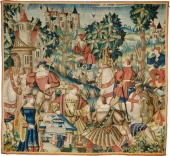Textile conservators work with a remarkable variety of materials spanning the past six centuries. A velvet Gothic cape from the 15th century, a wool, silk, and metallic yarned Netherlandish tapestry from the 15th and 16th centuries, and a 16th-century silk medallion carpet are some early examples. More recent textiles from various disciplines include avant-garde ballet costumes of the 20th century and a one-ton tapestry achieving full architectural scale.
Researchers gain great benefit from understanding the process (weave structure—high-warp loom) associated with the production (dye chemistry) of textiles. Therefore, regular additions are made to the textile study collection of dye plant, fiber, pigment, natural and synthetic fabrics, and related materials. The collection, along with other media, is used for scientific analysis—LC–MS (liquid chromatography–mass spectrometry), stereo-microscopy—which informs decisions about appropriate storage, exhibition, transport, treatment, general care, and preservation of the Gallery’s textile collection.
Our expert staff carries out well-researched treatments in collaboration with curatorial staff and, where appropriate, colleagues from other institutions, following guidelines set by national (American Institute for Conservation, or AIC) and international (International Institute for Conservation, or IIC) codes of ethics in the conservation field.
We occasionally host international symposia and publish proceedings contributing to the body of knowledge in the field and associated areas of study.
It is with a profound respect for the artist that we approach the full complement of our duties to preserve works of art for future generations.
